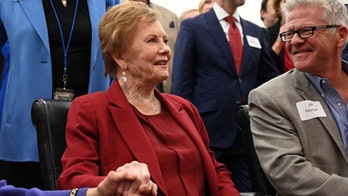GOP newcomer Madison Cawthorn reacts to winning North Carolina seat
North Carolina Republican Congressman-elect Madison Cawthorn tells 'Fox & Friends' what he plans to prioritize when he arrives in Washington, D.C.
The rapid influx of out-of-state transplants in North Carolina has drastically transformed its electorate, not only deepening the divide between rural red and urban blue areas, but also creating new political battlegrounds, as suburbs from larger cities like Charlotte and Raleigh have sprawled into older industrial towns.
The North Carolina State Board of Elections had not officially called the race for either presidential candidate as of Monday, six days after polls closed nationwide.
As of Monday, President Trump was leading by just 75,385 votes. He claimed 49.96% of the ballots counted so far, compared to the 48.58% tallied for former Vice President Joe Biden, according to the unofficial results published on the North Carolina State Board of Elections website. Biden was declared the projected winner and president-elect Saturday by most outlets, including the Fox News Decision Desk.
But Trump appeared to carry the state by a narrow margin not only due to support in rural communities -- but also because he won over melting pots like Gastonia, Ferrel Guillory, director of the Program on Public Life at the University of North Carolina at Chapel Hill told Fox News on Monday.
GOP NEWCOMER MADISON CAWTHORN WINS NORTH CAROLINA CONGRESSIONAL SEAT VACATED BY MARK MEADOWS
In Gaston County, Gastonia sits within Charlotte’s orbit, as many residents commute from the old mill village, which maintains its blue-collar roots but has grown more suburban. Union County, also outside Charlotte, and Johnston County, outside the state capital of Raleigh, take on similar constructs and have seen fierce competition between Republicans and Democrats, according to Guillory.
“Some rural areas, particularly those rural areas with the majority White population, have become increasingly Republican," he said. "But what the urban-rural divide construct analysis misses is what happens in Union County, which is just outside of Charlotte, and Johnston County, just outside of Raleigh. These are formerly small town communities but are now major suburban communities of fast growth."
Guillory said Trump’s decision to host a rally in Gastonia in mid-October also signaled that the campaign knew the importance of addressing a crowd in the satellite city weeks before Election Day.

Damon Akins, from left, Colleen Trimble and Kathryn Shields drink champagne at a celebration for President-elect Joe Biden in Greensboro, N.C., on Saturday, Nov. 7, 2020.
(Khadejeh Nikouyeh/News & Record via AP)
Trump claimed 63.39% of the ballots counted in Gaston County, 61.45% of those in Union County, and 61.47% in Johnston County, according to the unofficial election results tallied Monday.
WHY NORTH CAROLINA IS TAKING SO LONG TO COUNT VOTES?
As projected for a Democratic candidate, Biden carried Mecklenburg and Wake counties -- home to Charlotte and Raleigh, respectively. Compared to 2016, and with increased voter turnout considered, both the Democratic and Republican votes increased in the two counties, Guillory said.
Seven county boards of elections in North Carolina met Monday to consider a total of at least 3,200 additional absentee by-mail ballots. Last week, 10 county boards of elections added about 4,750 absentee ballots to the unofficial totals.
County boards will meet through Friday to consider additional absentee by-mail ballots that arrive at their offices through Thursday, provided they were postmarked on or before Election Day, Nov. 3.
“We are nearing the finish line,” Karen Brinson Bell, executive director of the State Board of Elections, said in a statement Monday. “We ask that the public please be patient as county boards of elections, as required, continue to count all eligible ballots that arrive by mail, conduct thorough post-election audits and certify their results.”
About four out of 10 North Carolina residents were born elsewhere, either in another state or a different country, according to Carolina Demography, which uses U.S. Census data to keep track of growth in the state. Raleigh is the second-fastest-growing metropolitan area in the U.S., behind just Austin, Texas. Charlotte is the eighth-fastest-growing area based on the latest 2019 population estimates.
Besides North Carolina, Texas and Florida are the only other states with multiple large and fast-growing metro areas.
CLICK HERE TO GET THE FOX NEWS APP
Along with the city of Durham and the town of Chapel Hill, Raleigh makes up an area called the Research Triangle, a booming hub for tech and pharmaceutical companies supported by research at North Carolina State University, Duke University, and the University of North Carolina at Chapel Hill. These new jobs attract residents from across the country. Meanwhile, Charlotte is growing most quickly with millennials and is expected to grow by another 300,000 people by 2040.






